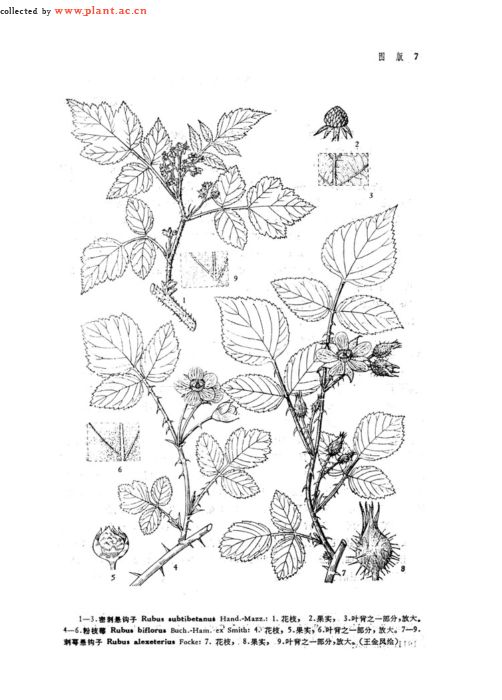粉枝莓Rubus biflorus Buch.-Ham. ex Smith
粉枝莓Rubus biflorus Buch.-Ham. ex Smith
36.粉枝莓(中国高等植物图鉴)二花莓(经济植物手册),二花悬钩子(秦岭植物志)
Rubus biflorus Buch.-Ham. ex Smith in Rees, Cyclop. 30: Rubus no. 9. 1819; Hook. f. Fl. Brit. Ind. 2: 338. 1878; Focke, Bibl. Bot. 72(2): 166. 1911: Hand.-Mazz. Symb. Sin. 7: 501. 1933; Merr. in Brittonia 4:83. 1941;中国高等植物图鉴2: 277.图2284. 1972; 秦岭植物志1(2): 532. 1974: ——R. biflorus Buch.-Ham. ex Smith var. quinqueflorus Focke in Sarg. Pl. Wils. 1: 53. 1911.
种中文名:粉枝莓
种拉丁名:Rubus biflorus Buch.-Ham. ex Smith
种别名 :
国内分布:陕,甘,川,滇,藏
海 拔:1500-3500
中国植物志:37:076
英文植物志:9:217
亚组中文名:绒毛叶亚组
亚组拉丁名:Subsect.Stimuiantes
组中文名:空心莓组
组拉丁名:Sect.ldaeobatus Focke
属中文名:悬钩子属
属拉丁名:Rubus
亚科中文名:蔷薇亚科
亚科拉丁名:ROSOideae Pocke
科中文名:蔷薇科
科拉丁名:Rosaceae
纲中文名:双子叶植物纲
纲拉丁名:DICOTYLEDONEAE
门中文名:被子植物门
门拉丁名:ANGIOSPERMAE
参考文献:Rubus biflorus Bilch.—Ham.Cx Smith in Rees,Cyclop.30:Rubus no .9.1819;Hook. F.F1.Brit.Ind.2:338.1878;Focke;BiN.Bot.72(2):166.1911;Hand.—Mazz.Symb. Sin.7:501.1933;Merr. In Brittonia 4:83.1941;中国高等植物图鉴2:·277.图2284. 1972;秦岭植物志1(2):532.1974:——R.Biflorus buch.·Ham.exSmith var.quinqufl- orus Focke in Sarg·P1.Wils.1:53.1911.
亚组概述:Subsect.Stimuiantes:Yu et.Lu,.植物分类学报20(3):299.1982.-Sect.Pungentes Focke,Bibl.Bot.72(2):160;1911 et,83:40. 1914·P.P. -Sect。Ldaeanthi Focke,L c.72(2):171.1911,et 83:·43.1914.P.P。 本亚组有下列13种。
《Flora of China》 Vol. 9 (2003)
Rubus biflorus Buchanan-Hamilton ex Smith
粉枝莓 fen zhi mei
Shrubs climbing, 1–3 m tall. Branchlets purplish brown to brownish, glabrous, with sparse, robust curved prickles and glaucous bloom. Leaves imparipinnate, 3-foliolate, rarely 5-foliolate; petiole 2–4(–5) cm, petiolule of terminal leaflet 1–2.5 cm, lateral leaflets subsessile, glabrous, rarely pilose, sparsely stipitate glandular; stipules narrowly lanceolate, 6–8 mm, pubescent, with few stipitate glands; terminal leaflet blade broadly ovate or suborbicular, lateral blade of leaflets ovate or elliptic, 2.5–5 × 1.5–4(–5) cm, abaxially densely gray or yellowish gray tomentose, with sparse, minute prickles along midvein, adaxially appressed pubescent, base broadly cuneate to rounded, margin unevenly coarsely serrate or doubly serrate, often 3-lobed on terminal leaflet, apex acute or acuminate. Inflorescences terminal, rarely axillary, corymbs, 4–6 cm, often 4–8-flowered, or flowers 2 to several in clusters in leaf axils; rachis and pedicels glabrous, with needle-like prickles; bracts linear or narrowly lanceolate, 4–7 mm, glabrous, rarely pilose. Pedicel (1–) 2–3 cm. Flowers 1.5–2 cm in diam. Calyx abaxially glabrous; sepals erect, spreading at anthesis, broadly ovate or orbicular-ovate, 6–8 × 5–7 mm, apex acute, apiculate. Petals white, suborbicular, 7–8 mm in diam., longer than sepals. Stamens many, shorter than petals; filaments linear, broader at base. Pistils somewhat shorter than stamens; apex of ovary and base of style densely gray tomentose. Aggregate fruit enclosed in calyx, yellow, globose, 1–1.5(–2) cm in diam., glabrous; drupelets apically with persistently tomentose styles; pyrenes reniform, densely rugulose. Fl. May–Jun, fr. Jul–Aug.
Valleys, river sides, slopes, roadsides, thickets, forests, forest margins; 1500--3500 m. Gansu, Guizhou, Shaanxi, Sichuan, Xizang, Yunnan [Bhutan, NE India, Kashmir, Myanmar, Nepal, Sikkim].
别名:粉枝梅;莓泡;二花莓;倒竹伞;甘札嘎日;粉茎悬钩子;二花悬铃子;白枝刺泡;白泡刺;二花悬钩子;
科名:蔷薇科 Rosaceae
属名:悬钩子属 Rubus

36.粉枝莓(中国高等植物图鉴)二花莓(经济植物手册),二花悬钩子(秦岭植物志)
Rubus biflorus Buch.-Ham. ex Smith in Rees, Cyclop. 30: Rubus no. 9. 1819; Hook. f. Fl. Brit. Ind. 2: 338. 1878; Focke, Bibl. Bot. 72(2): 166. 1911: Hand.-Mazz. Symb. Sin. 7: 501. 1933; Merr. in Brittonia 4:83. 1941;中国高等植物图鉴2: 277.图2284. 1972; 秦岭植物志1(2): 532. 1974: ——R. biflorus Buch.-Ham. ex Smith var. quinqueflorus Focke in Sarg. Pl. Wils. 1: 53. 1911.
种中文名:粉枝莓
种拉丁名:Rubus biflorus Buch.-Ham. ex Smith
种别名 :
国内分布:陕,甘,川,滇,藏
海 拔:1500-3500
中国植物志:37:076
英文植物志:9:217
亚组中文名:绒毛叶亚组
亚组拉丁名:Subsect.Stimuiantes
组中文名:空心莓组
组拉丁名:Sect.ldaeobatus Focke
属中文名:悬钩子属
属拉丁名:Rubus
亚科中文名:蔷薇亚科
亚科拉丁名:ROSOideae Pocke
科中文名:蔷薇科
科拉丁名:Rosaceae
纲中文名:双子叶植物纲
纲拉丁名:DICOTYLEDONEAE
门中文名:被子植物门
门拉丁名:ANGIOSPERMAE
参考文献:Rubus biflorus Bilch.—Ham.Cx Smith in Rees,Cyclop.30:Rubus no .9.1819;Hook. F.F1.Brit.Ind.2:338.1878;Focke;BiN.Bot.72(2):166.1911;Hand.—Mazz.Symb. Sin.7:501.1933;Merr. In Brittonia 4:83.1941;中国高等植物图鉴2:·277.图2284. 1972;秦岭植物志1(2):532.1974:——R.Biflorus buch.·Ham.exSmith var.quinqufl- orus Focke in Sarg·P1.Wils.1:53.1911.
亚组概述:Subsect.Stimuiantes:Yu et.Lu,.植物分类学报20(3):299.1982.-Sect.Pungentes Focke,Bibl.Bot.72(2):160;1911 et,83:40. 1914·P.P. -Sect。Ldaeanthi Focke,L c.72(2):171.1911,et 83:·43.1914.P.P。 本亚组有下列13种。
《Flora of China》 Vol. 9 (2003)
Rubus biflorus Buchanan-Hamilton ex Smith
粉枝莓 fen zhi mei
Shrubs climbing, 1–3 m tall. Branchlets purplish brown to brownish, glabrous, with sparse, robust curved prickles and glaucous bloom. Leaves imparipinnate, 3-foliolate, rarely 5-foliolate; petiole 2–4(–5) cm, petiolule of terminal leaflet 1–2.5 cm, lateral leaflets subsessile, glabrous, rarely pilose, sparsely stipitate glandular; stipules narrowly lanceolate, 6–8 mm, pubescent, with few stipitate glands; terminal leaflet blade broadly ovate or suborbicular, lateral blade of leaflets ovate or elliptic, 2.5–5 × 1.5–4(–5) cm, abaxially densely gray or yellowish gray tomentose, with sparse, minute prickles along midvein, adaxially appressed pubescent, base broadly cuneate to rounded, margin unevenly coarsely serrate or doubly serrate, often 3-lobed on terminal leaflet, apex acute or acuminate. Inflorescences terminal, rarely axillary, corymbs, 4–6 cm, often 4–8-flowered, or flowers 2 to several in clusters in leaf axils; rachis and pedicels glabrous, with needle-like prickles; bracts linear or narrowly lanceolate, 4–7 mm, glabrous, rarely pilose. Pedicel (1–) 2–3 cm. Flowers 1.5–2 cm in diam. Calyx abaxially glabrous; sepals erect, spreading at anthesis, broadly ovate or orbicular-ovate, 6–8 × 5–7 mm, apex acute, apiculate. Petals white, suborbicular, 7–8 mm in diam., longer than sepals. Stamens many, shorter than petals; filaments linear, broader at base. Pistils somewhat shorter than stamens; apex of ovary and base of style densely gray tomentose. Aggregate fruit enclosed in calyx, yellow, globose, 1–1.5(–2) cm in diam., glabrous; drupelets apically with persistently tomentose styles; pyrenes reniform, densely rugulose. Fl. May–Jun, fr. Jul–Aug.
Valleys, river sides, slopes, roadsides, thickets, forests, forest margins; 1500--3500 m. Gansu, Guizhou, Shaanxi, Sichuan, Xizang, Yunnan [Bhutan, NE India, Kashmir, Myanmar, Nepal, Sikkim].

